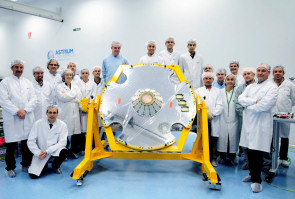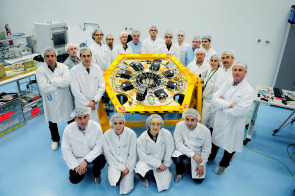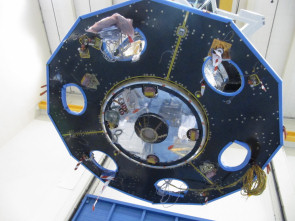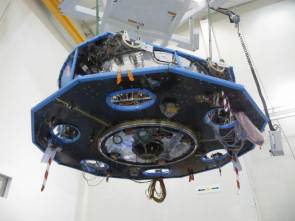#04: Gaia Phased Array Antenna delivered and integrated
6 July 2012
The phased array antenna that Gaia will use to send its science data to Earth has been delivered and integrated onto the Service Module. The antenna provides the high gain and data rate needed to allow large volumes of data to be transmitted over the 1.5 million kilometres that will separate the spacecraft's operational orbit from Earth. The use of electronic beam steering allows the signal to be directed towards Earth as the spacecraft rotates; a conventional, mechanically pointed antenna would cause microvibrations, seriously impacting the performance of the telescope.High data rate
The Gaia mission will perform astrometric measurements on over one billion objects in the Milky Way and its Local Group. To do this, the spacecraft will spend five years in a Lissajous orbit around the second Lagrange point of the Sun-Earth system (L2), which is located 1.5 million km from Earth in the anti-Sun direction.
Gaia will generate an enormous volume of data – about 200 TB (uncompressed) over its nominal five-year mission. Even with data compression, the restrictions imposed by the size of the on-board solid-state mass memory (constrained by cost, mass, power consumption and reliability considerations), the ~8 hour per day ground station downlink window and the desire not to discard data impose a requirement for an extremely high downlink rate of up to 8.7 Mbps, given the distance over which the data has to be communicated.
 |
 |
|
Left: Gaia Antenna Support Panel on ground handling trolley. Right: Rear face of Gaia Antenna Support Panel. Credit: Courtesy of Astrium, 2012 |
|
Beam steering
Gaia will perform its measurements by simultaneously observing two target fields. The spacecraft will rotate around its longitudinal axis at a rate of 60 arcsec/s, equivalent to a spin period of six hours, to scan its fields of view across the sky. The downlink antenna is mounted on the Sun-pointing face of the Service Module, which is perpendicular to the rotation axis. The antenna beam must be steered, to keep it pointed at Earth both as the spacecraft rotates and as it moves through its orbit around L2.
Conventional dish antennas address requirements of this type by employing mechanical rotation or steering. However, the very stringent requirements regarding microvibration make the use of mechanisms infeasible for Gaia. The chosen alternative solution is to use a phased array antenna that accomplishes beam steering through electronic means.
A phased array antenna is made up of a number of radiating elements and a system for shifting the phase of the signal that is fed to each element. By adjusting the phase of the signal radiated by each of the elements, interference is employed to steer the radiated beam in the desired direction. Constructive interference gives rise to a peak in the radiation pattern, while destructive interference helps to improve the sharpness of the beam.
Gaia Phased Array Antenna
The Gaia Phased Array Antenna (PAA) forms part of the spacecraft Telemetry, Tracking and Command (TT&C) subsystem and operates at X band. The TT&C subsystem acts as the interface between the spacecraft and its ground stations and, in addition to typical TT&C functions, it supports high data rate downlinking of science data. The PAA will also be used to support a ranging function for the spacecraft, requiring high phase stability from the hardware.
 |
 |
|
The Gaia Service Module with the Phased Array Antenna. Credit: Courtesy of Astrium, 2012 |
|
All PAA hardware is mounted on an Antenna Support Panel that is, in turn, fixed to the Sun-pointing face of the Gaia spacecraft. The Radiating Cone is mounted on the exterior surface of the support panel; all other subsystems are mounted on the 'internal' face. The PAA hardware and the antenna panel are thermally isolated from the spacecraft by a thermal tent, with the Antenna Support Panel providing the radiating surfaces needed to reject the heat generated by the PAA.
The Radiating Cone is a 14-sided truncated pyramid; its primary structure is machined from solid aluminium alloy. Each facet has two sub-arrays, each comprised of six radiating elements; each sub-array has a series of RF couplers that split the incoming signal to provide the amplitude weighting that determines the radiation pattern of the sub-array. The overall antenna radiation pattern is obtained by combining the radiation patterns from the 14 sub-arrays on the Earth-pointing side of the radiating cone.
The 28 antenna sub-arrays are fed by seven 'Quadri-Modules', which provide low-level gain, phase and amplitude control, power amplification and routing of signals to the appropriate sub-arrays. The Quadri-Modules are, in turn, fed by a 2:7-way splitter that allows the spacecraft's nominal or cold-redundant transponder to feed the PAA.
The PAA Electronic Power and Interface Controller (EPIC) contains a secondary voltage converter for power from the Gaia spacecraft primary power bus and a TT&C remote control terminal for the Gaia 1553B spacecraft data bus. EPIC provides all secondary power and control signals required by the seven Quadri-Modules within the PAA. EPIC also acquires operational telemetry from the Quadri-Modules and passes it to the spacecraft via the 1553 bus, along with its own health telemetry.
The Gaia PAA has a gain of about 16.8 dB. The 28 Solid-State Power Amplifiers (SSPAs) deliver a total of nearly 59 W (~17.7 dBW) to achieve an Effective Isotropic Radiated Power (EIRP) of just over 34 dBW (~2.6 kW).
About Gaia
Gaia will create a three-dimensional map of the Milky Way, in the process revealing information about its composition, formation and evolution. The mission will perform positional measurements for about one billion stars in our Galaxy and Local Group with unprecedented precision, together with radial velocity measurements for the brightest 150 million objects. Gaia is scheduled to launch in 2013 for a nominal five-year mission, with a possible one-year extension.
The spacecraft will operate in a Lissajous orbit around the second Lagrange point of the Sun-Earth system (L2). This location in space offers a very stable thermal environment, very high observing efficiency (since the Sun, Earth and Moon are all behind the instrument FoV) and a low radiation environment. Uninterrupted mapping of the sky will take place during the operational mission phase.
The Prime Contractor for Gaia is Astrium SAS, based in Toulouse, France. The contractor responsible for development and integration of the PAA is EADS CASA Espacio, based in Madrid, Spain.




